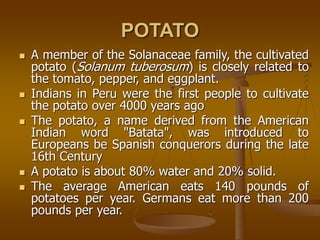
1610729981-lec-5bs-agri-pp-morning-a.ppt
- 1. POTATO A member of the Solanaceae family, the cultivated potato (Solanum tuberosum) is closely related to the tomato, pepper, and eggplant. Indians in Peru were the first people to cultivate the potato over 4000 years ago The potato, a name derived from the American Indian word "Batata", was introduced to Europeans be Spanish conquerors during the late 16th Century A potato is about 80% water and 20% solid. The average American eats 140 pounds of potatoes per year. Germans eat more than 200 pounds per year.
- 2. Nutritional value per 100 g Carbohydrates 19 g Starch 15 g Dietary fiber 2.2 g Fat 0.1 g Protein 2 g Water 75 g Thiamin (Vit. B1) 6% Riboflavin (Vit. B2) 2% Niacin (Vit. B3) 7% Vitamin B6 19% Vitamin C 33% Calcium 1% Iron 14% Magnesium 6% Phosphorus 8% Potassium 9% Sodium 0%
- 3. EARLY BLIGHT OF POTATO Symptoms: The initial symptoms appear in the form of small, isolated scattered pale brown spots on leaves with deep greenish-blue fungal growth of fungus. The lower leaves are attacked first and then the disease progresses upwards. In the necrotic tissue, concentric ridges develop, which give a target board effect. The stem lesions often girdle it and cause “Collar-rot” in young seedling plants leading to collapse of branches or entire above ground portion. On tubers the affected region is darker than the healthy area and the lesion soon shrinks slightly as dry, corky rot develops.
- 7. Causal organism: Alternaria solani Disease Cycle: Mycelium and conidia can survive in plant debris and on seed tubers. The conidia germinate in moist weather and cause primary infection directly or through stomata, first on lower and then on upper leaves. The secondary infection takes place through conidia carried by wind, water or insects.
- 8. Epidemiology The optimum temperature for conidial germination is 28-30ºC. If season starts with abundant moisture and frequent rains, disease becomes serious, followed by warm and dry weather, which is unfavourable for the host but helps rapid disease development. Weaker plants are more susceptible.
- 9. CONTROL Crop rotation and field sanitation is a rational measure to avoid primary infection from spores that have survived from previous crop. Fungicidal sprays starting from 30 days after sowing at an interval of 10-21 days (depending upon the intensity of disease). For this purpose, Dithane M-45 (0.6%), Daconil (0.3%), Acrobat MZ, Ridomil Gold MZ, Banko (0.2 – 0.25%) can be used. Proper fertilization of the crop to maintain the plant vigour
- 10. LATE BLIGHT OF POTATO The disease was recorded simultaneously in Europe and North America in 1830. It became very well established in Europe by 1842 and was one of the important causes of the great Irish famine in 1845 and 1846. It invaded the sub-continent between 1870 and 1880. This is extremely destructive to tomato and eggplant and many other solanaceous hosts except pepper. It may bring about as much as 10-15 percent losses to world production of potatoes during certain years.
- 11. SYMPTOMS The first symptoms appear in the form of brown dead spots or extended necrotic areas more frequently until the leaves are killed. These blighted areas first appear as faded green patches, which soon turn to brownish black lesions not delimited in size. These lesions enlarge rapidly under favourable weather. They appear on tips of margins of the leaves and spread downwards or inwards. In moist weather, entire leaf may be killed in 1-4 days.. On lower surface of leaves, a whitish or grayish mildew growth appears on the surface of lesions where pale and purplish tissues merge. This contains sporangiophores and sporangia, which grow out through stomata.
- 14. Causal organism: Phytophthora infestans Disease Cycle: Fungus survives mostly as persistent mycelium in the infected tubers, but it may overwinter in soil as well. This mycelium grows up in the stem and produces sporangia and zoospores on small dwarf shoots. The secondary infection starts from these spores. Infection takes place epidermis of leaves and stem either through stomata or directly. Tuber infection occurs through eyes, lenticels or wounds. Susceptibility of eyes and resistance of lenticels increases with storage and maturity of tubers. Spores from blighted leaves are washed down to soil and cause tuber infection.
- 16. EPIDEMIOLOGY The favorable conditions for the blight, extended periods of cool and wet weather, are explained by the biology of the parasitizing fungus. Sporangia best survive dispersal by air when the air is humid, and water is necessary for infection by the fungus. In addition, zoospores are produced at cooler temperatures, which maximizes the number of potential infections possible from a single sporangium Germination and infection always require water on the leaf surface. At higher temperatures (over 68°F or 20°C), the sporangia germinate by producing a single germination tube rather than zoospores. Thus, the number of potential infections from a single sporangium is greatly reduced in warmer environments, although disease is not eliminated.
- 17. MANAGEMENT Dispose of cull potatoes and seed chips properly by burying to a depth of 2 feet before any potatoes emerge in the spring. Control volunteer potato plants as they emerge. Plant certified seed that is free of late blight (from late- blight-free production areas). Do not over-irrigate. Monitor irrigations carefully. Do not irrigate when free moisture will stay on leaves for an extended time, i.e. try to water during late night and early morning so foliage can dry quickly during daytime hours. Avoid having wet spots in fields. Shut off the inner two towers of center pivot systems. Apply protectant fungicides. Apply the protectant when foliage is 6" high and again just before row closure. Apply additional fungicides according to the disease risk.
- 18. Early Blight Late blight High temperature and low moisture is required Reverse in this case Appears early in season Reverse in this case Appears in Plains Appears in Hilly areas Caused by a higher fungus Caused by a lower fungus